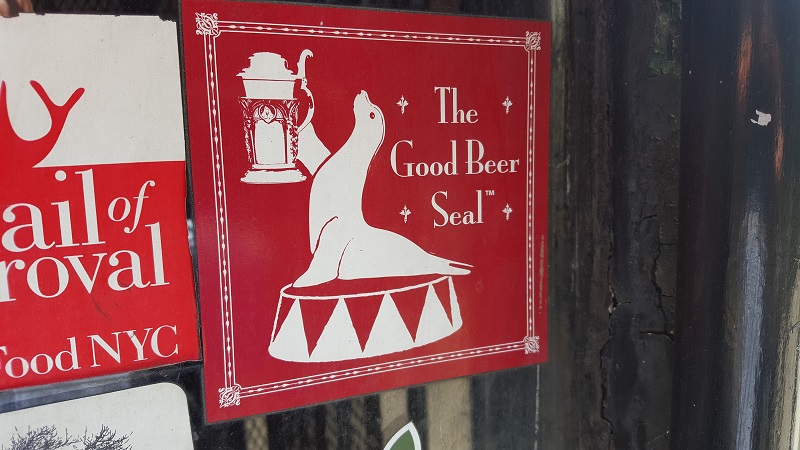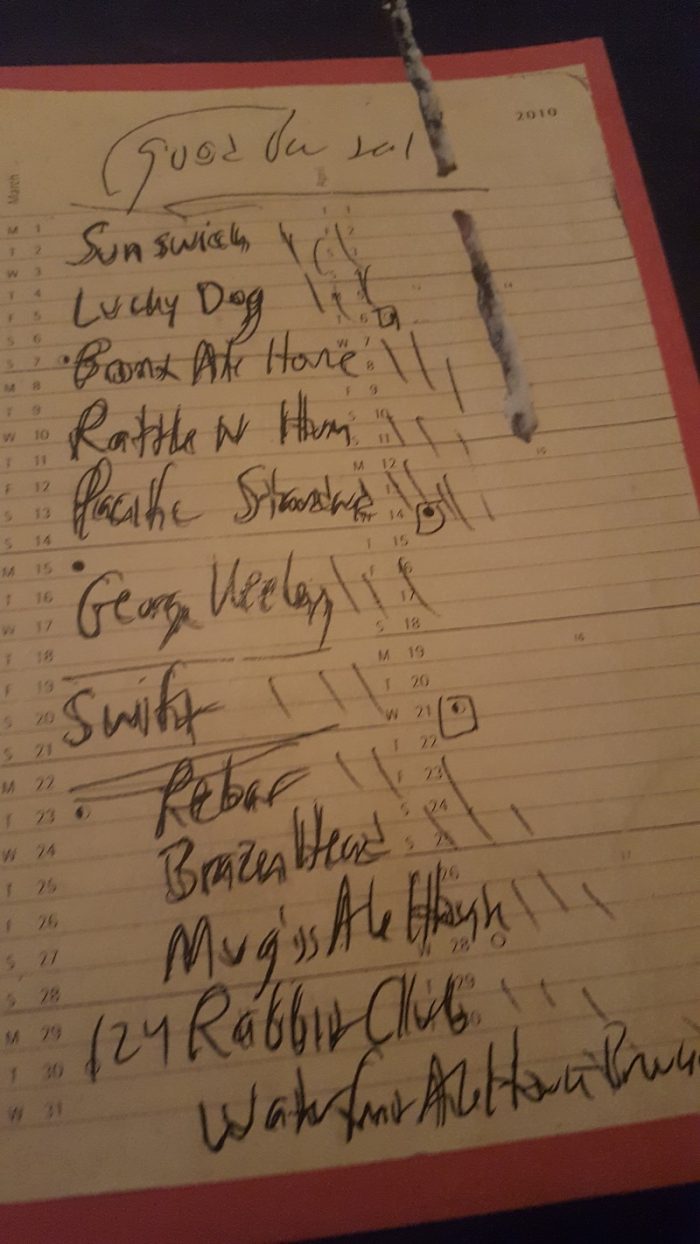Craft Beer’s First Seal of Independence
The idea was a simple one: a seal to honor those independently owned purveyors of smaller-batch, more traditionally made beer. The seal caught on pretty quickly after it was announced, and, eventually, dozens of such purveyors proudly bore it.
The Brewers Association’s recently announced Independent Craft Brewer Seal? No. It’s the Good Beer Seal that six New York City bar owners launched in 2009 to honor and differentiate those bars (like theirs) serving and promoting “craft” beer.

The Good Beer Seal outside Jimmy’s No. 43 in Manhattan. (Photo courtesy Jimmy Carbone)
Two things inspired the Good Beer Seal.
One, restaurants in New York City were slapping the Slow Food movement’s Snail of Approval seal on their windows and materials, a way of telling potential customers that the food they might enjoy was prepared carefully and from quality ingredients, often local.
The other was that New York state did not allow breweries to sell their wares by the glass on-site—that would not come until 2014. In 2009, it was only samples at the end of a tour, say.
“We saw ourselves as kind of the tasting rooms,” says Jimmy Carbone, owner of Manhattan’s Jimmy’s No. 43 and one of those half-dozen bar owners behind the seal.
Originally limited to bars in New York’s five boroughs, bars in the city’s immediate region were eventually allowed to earn it as well. Plus, Carbone said that bars in other cities, including Chicago, may be eligible starting next year.

The vote tally for 2010 Good Beer Seal inductees. (Photo courtesy Jimmy Carbone)
A committee, none of whose members are affiliated with a Good Beer Seal bar, picks inductees. The seal is not consecrating any new members this year, though. Instead, a July 20 event that’s part of July Good Beer Month in New York, will honor the approximately 70 existing seal holders.
Although the Brewers Association says that the Good Beer Seal did not influence its new Independent Craft Brewer Seal, the two share unmistakable similarities.
The biggest one is a jones for ownership independence. Only bars that are mostly, if not solely, independently owned and operated are eligible for the Good Beer Seal. Only breweries, brewpubs and brewing companies that are mostly, if not solely, independently owned are eligible for the Independent Craft Brewer Seal.
There is also a shared commitment to a certain type of beer. In the BA’s case, it’s that type of beer that fits the trade group’s definition of “craft”—made with certain ingredients (and without certain others), in certain amounts within certain time periods.
For the Good Beer Seal, only bars that show what its founders describe as a “commitment” to carrying and properly serving “the best beers”—mostly domestic microbrewers and specialty imports—can slap the designation on their property.
The actual criteria aside for either seal, both seals were also born of a boom in brewing and a desire to sort it all out for consumers, a desire that fit nicely and not uncoincidentally with self-promotion. In New York, it was the jump in the sheer number of beers available from smaller producers. Nationally, it was the jump in that number of smaller producers.
Whereas in New York City a generation before Good Beer Seal’s 2009 debut there might have been a handful of specialty imports available and the odd West Coast indy on tap—think Anchor or Sierra Nevada—the number had marched steadily upward.
There were dozens of labels available by the late 1990s, many locally produced—participants in the second annual New York City Brewpub Crawl Marathon in 1996 had the pick of up to 72 beers from 12 brewpubs—and hundreds by the late 2000s.
Nationally, the producers behind those labels had famously multiplied, from a few hundred in the late 1990s to the record 5,300 and counting nowadays. Not all of those breweries are independently owned.
That led the BA to further try to sort things out for consumers (after all, not every beer drinker is tuning into the latest debate about the definition of a craft brewer). A desire to cut through the noise seems to ballast the point of both the Independent Craft Brewer Seal and the older Good Beer Seal.
The Good Beer Seal started one year after the first New York Craft Beer Week—now simply New York Beer Week—when it was clear residents were willing to pour into establishments to spend money on all those labels flooding the nation’s largest city.
Here was a way to steer those patrons to the bars that served these “best beers” properly and with a side of explanation from servers and bartenders. The seal’s originators also in 2009 launched July Good Beer Month to highlight not only local breweries and brewpubs, but attendant businesses such as beer-focused bars.

(Photo courtesy the Brewers Association)
As for the Independent Craft Brewer Seal, it launched after the start of a trend in macro-brewers such as Anheuser-Busch buying up formerly independent, smaller-batch breweries—and then continuing on as if nothing much had changed.
The Brewers Association saw it as a way to guide consumers to those smaller producers still independently owned. It doesn’t hurt that those who use the seal are invariably BA members anyway.
Tom Acitelli is the author of The Audacity of Hops: The History of America’s Craft Beer Revolution, now in its second edition, and the new Whiskey Business: How Small-Batch Distillers Are Transforming American Spirits.

Leave a Reply